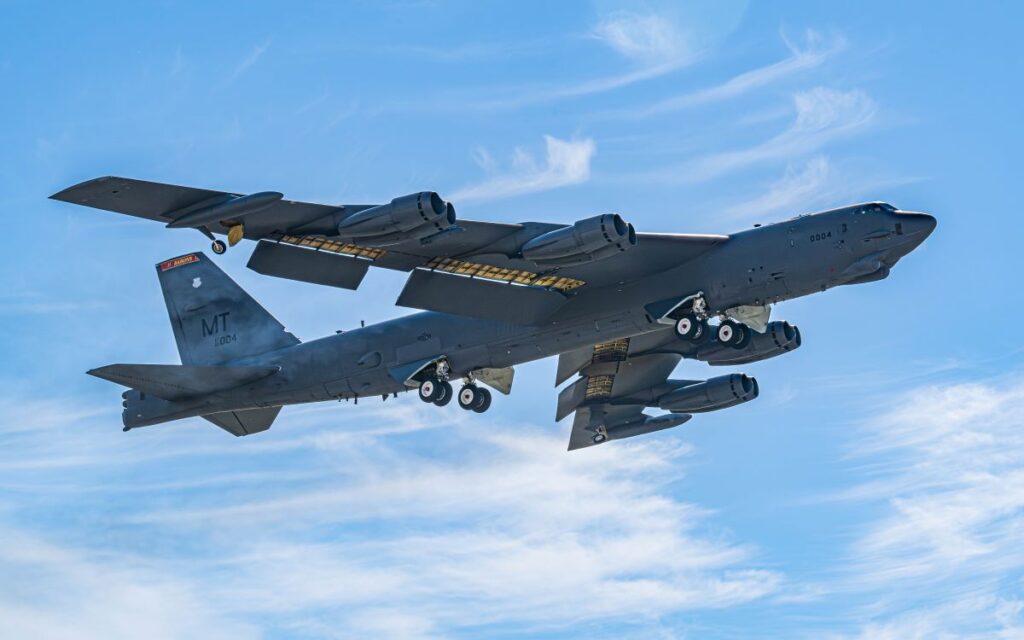
Pictured is a B-52H Stratofortress assigned to the 23rd Expeditionary Bomb Squadron taking off in support of Bomber Task Force Europe at Morón Air Base, Spain on May 27 (U.S. Air Force Photo)
The U.S. Air Force said that wind tunnel testing that finished in early June validated inlet redesign of the Rolls-Royce F130 engine for the U.S. Air Force’s Commercial Engine Replacement Program (CERP) for the Boeing B-52H bomber, as the program looks to enter development this summer.
In December 2023, the Air Force approved the transition of CERP from Middle Tier of Acquisition (MTA) rapid prototyping to Major Capability Acquisition (MCA).
“In December 2023, the program received Air Force approval to transition to the MCA pathway before development start, but development start has been delayed by nearly a year—to June 2025,” according to the Government Accountability Office’s annual weapons systems assessment released this week.
“According to the program, delays stem from ongoing engine inlet issues the program found during design testing and from Boeing’s lag in submitting proposals needed for maturing the program’s cost and schedule baselines,” the assessment said. “Officials stated that Boeing submitted qualified proposals in summer 2024 that the program is currently reviewing. As part of ongoing design work, officials identified a critical issue regarding engine inlet distortion—a non-uniform flow of air that can affect the engine’s performance and operability—resulting in a redesign of the engine inlet. While the program used a digital model during the rapid prototyping effort that simulated how prospective contractors’ engines would fit in the aircraft, officials said performance data from testing showed that the design did not meet requirements. Officials stated that Boeing will complete wind tunnel testing to fully verify the design in summer 2025. Officials stated that these data are essential to completing the critical design review [CDR], planned for April 2026, three years later than originally planned.”
The program said that it used digital modeling and digital engineering to complete the engine inlet redesign in December last year and that the inlet “now meets performance and operability requirements.”
The Rolls-Royce F130s are to replace the B-52H’s Pratt & Whitney [RTX] TF33-PW-103 engines, which the Air Force has said it wants to retire by 2030, yet the F130 is not to achieve initial capability and a full-rate production decision until January 2033.
In September 2021, the Air Force awarded Rolls-Royce a CERP contract worth up to $2.6 billion through fiscal 2038 to outfit the B-52 with the F130, based on Rolls-Royce’s commercial BR725 carried on Gulfstream [GD] G650 business jets.
CERP and the Radar Modernization Program are the Air Force’s key modernization efforts for the B-52H. The modernized bombers will carry the B-52J designation.
“We are proud of the strong progress we have made towards delivering the B-52J for the U.S. Air Force on time and on budget,” Scott Ames, Rolls-Royce’s program director for B-52 CERP, said in a company statement on June 12. “This spring, we moved into engine altitude testing at Arnold Engineering Development Complex in Tullahoma, Tennessee and continue to use cutting edge, digital engineering to inform our testing program and allow us to stay on track to deliver for the Air Force.”
‘Working closely with our partners at Boeing, we have met major program milestones including successfully holding the engine CDR, completing Rapid Twin Pod testing to support the B-52’s unique nacelle configuration, and finishing the first phase of sea-level testing in Indianapolis,” according to Ames.
A version of this story originally appeared in affiliate publication Defense Daily.